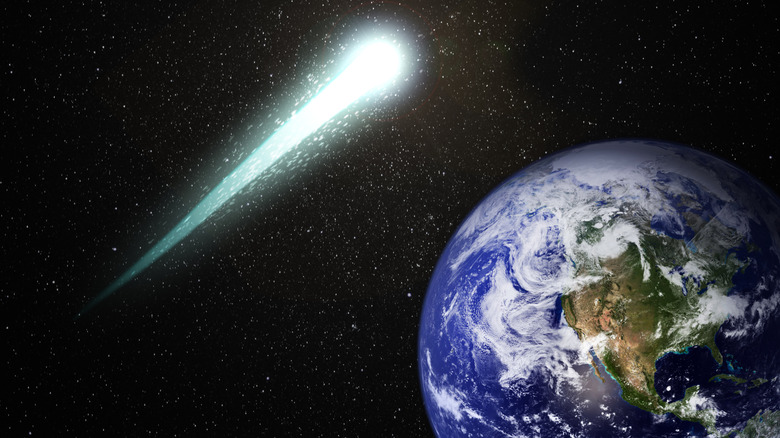First Radio Signal Could End 3I/Atlas Alien Debate For Good
It's difficult to believe that, given the enormous extent of outer space around us, there aren't other life forms out there. Humanity has long been intrigued by the idea, with movies, books, and TV shows presenting friendly aliens, malevolent aliens, indifferent aliens, and more. It's a cause of endless debate. This is what's made the story of 3I/Atlas so intriguing. This comet is a very distant visitor, deriving its name from the fact that it's only the third interstellar (meaning from beyond the Solar System itself) object that science has identified as such. The Asteroid Terrestrial-impact Last Alert System (ATLAS) first detected its existence in mid-June 2025, and the first observations continued into July. The most intriguing aspect of this object is that, being from so far away, it could boast utterly unfamiliar properties. It could even be made by another species, and this is what some have been counting on.
The idea of 3I/Atlas as an alien spacecraft of some sort has been one that's intriguing many. With that in mind, astronomers and scientists around the world are desperate to demonstrate whether this interstellar interloper is naturally occurring or whether, just possibly, it was built by another civilization or species entirely. In October 2025, the South African Radio Astronomy Observatory caught the first radio signal from 3I/Atlas, and they are consistent with what astronomers would expect from a comet. Operating the MeerKat telescope system, they detected hydroxyl radicals (evidence of a water source), which are capable of absorbing the radiation, resulting in the signal. It is, it would seem, entirely natural after all. Let's take a look at what separates a comet from something even more astonishing than that.
What makes a comet a comet
It can be easy to confuse a comet with an asteroid. The difference is quite simple: The former is a ball of ice with some grit and smaller space detritus, while an asteroid is a hardier clump of space-rock. Meteorites, meanwhile, are what happens when a meteoroid survives its high-pressure trip through our atmosphere and actually makes it to Earth. The crucial thing they all have in common is that they're naturally occurring. We humans, of course, have put all manner of artificial objects in space, from the iconic International Space Station to the Hubble Space Telescope and a wide range of spacecraft to boot. As such, if 3I/Atlas can be confirmed to be a comet, it would be a fascinating research opportunity, but if it could be confirmed to be a non-terrestrial, artificial object, it would be absolutely mind-blowing.
The priority for scientists has been to monitor its behavior to determine whether it's consistent with everything we know about comets. From all that can be gleaned so far, it would seem this is the case. Researchers note that the pattern that 3I/Atlas is following is reminiscent of that of known comets. Penn State University astrophysicist and astronomer Jason Wright notes in his blog AstroWright, "it has a tail and coma like a comet. The tail and coma have the gases we expect to see from a comet. It's brightening and evolving as it warms up like comets do." Wright refutes the claims of Avi Loeb, who believes that the comet could be a spaceship because of anomalies in its nature. "Lots of comets are 'anomalous'," Wright states, going on to explain that "The first thing to understand about comets is that no two seem quite alike."
Why we believed that 3I/Atlas could be alien
It's difficult to blame anyone for having a desire to make the discovery of an alien spaceship, nor those who hear about it for wanting to believe. As Jason Wright noted, Avi Loeb is a proponent of the 3I/Atlas-as-alien-spacecraft theory, and indeed, Wright declares in AstroWright, "If Avi had not claimed it could be an alien spacecraft, no one would be talking about it as anything but a comet." It seems we shouldn't get too carried away by all those Area 51 myths and such. NASA refers to the object quite definitively as a comet and notes that it's definitely going to be a distant visitor, too. According to the outlet, it will pass no closer than approximately 170 million miles from Earth, and went out of telescope range in approximately September 2025. It is due to return to an observable state after returning from the Sun's other side in December 2025.
The BBC's Sky at Night Magazine states that "cosmetic flares or tricks of the light due to problems with the observations" could potentially be used by some who believe the comet to be artificial, as Wright suggests of Avi Loeb. The magazine notes that the object's movements appear to follow a predictable, natural course, as opposed to one influenced by potential spaceship engines. Though it may not have been crafted by the denizens of another planet, 3I/Atlas is estimated to be seven billion years old, potentially the oldest comet ever discovered. It's an extraordinary object, and is sure to continue to teach humanity about the depths of space as we continue to observe it. Alien technology might not be as sophisticated as we expect, according to one theory, but evidence of it is still elusive.


